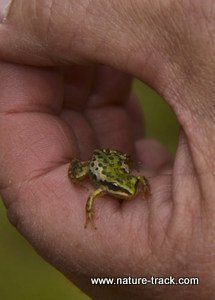Boreal Chorus Frog

Boreal chorus frogs are tiny things, a large one may be 1.5 inches long. It is easy to zero in on their big voices in the springtime but they are much harder to find in the fall.
Springtime mating rituals and their accompanying songs are long over. Now the woods are full of elk bugles and soon nighttime skies will echo the haunting calls of migrating geese. But springtime wildlife is still there, just often harder to find.
Such is the case with the diminutive boreal chorus frog. This frog is never easy to find, but after it stops singing in the springtime it becomes downright challenging. It is tiny, between three quarters and one and a half inches long for an adult. It is also secretive, apparently realizing that given its size, it is on the menu of just about every predator—fish, mammal or bird—out there. It is also usually nocturnal and with its base color of green or brown adorned with stripes or spots, it can be very hard to see.
That is why I was so surprised to find not one, but two recently on a hike near Grassy Lake. We were in a marshy area that I thought might hold some frogs. Cathy spotted one thumbnail sized one first, but before I could point the camera at it, it dove into the long grass and was gone.
It took a few minutes but we actually located another about the same size. Although I have heard chorus frogs many times, this was the first time I had ever actually seen one. It was so tiny that I actually wondered if I had a youngster of a different species.
Chorus frogs are pretty easy to identify. They are part of the tree frog family which is characterized by small size, long legs, little webbing between the toes and a slim waist. There are members of this family residing on every continent except Antarctica, but of the 600 species, Idaho’s Comprehensive Wildlife Conservation Strategy (State Wildlife Action Plan) lists only two chorus frogs in Idaho: Boreal and Pacific tree frog. These can be distinguished by the dark eye stripe that runs from nose to hip in the boreal chorus frog and from nose to shoulder in the Pacific tree frog.
You won’t confuse the two because their distributions don’t overlap in Eastern Idaho. The boreal chorus frog can be found in the eastern portion of the state, and along the Snake River Plain to the western border. The Pacific tree frog lives from the center of the state north to Canada.
Despite their normally secretive nature, come springtime, boreal chorus frog males join together and become loud and boisterous as they sing like drunken pirates to attract breeding females. These vocalizations sound much like quickly dragging a fingernail across the teeth of a comb and may occur 20-40 times a minute.
Chorus frogs are about ready to pack it in and call it a year. They will spend the winter hibernating beneath logs, abandoned burrows or even the bottom of the marsh. So if you happen to see one, wish it well on its winter’s sleep and listen for it next spring.

"WOW. What a phenomenal piece you wrote. You are amazing." Jennifer Jackson
That is embarrassing, but actually a fairly typical response to my nature essays. Since The Best of Nature is created from the very best of 16 years of these nature essays published weekly in the Idaho Falls Post Register (online readership 70,000), it is a fine read. It covers a wide variety of topics including humorous glimpses of nature, philosophy, natural history, and conservation. Readers praise the style, breadth of subject matter and my ability to communicate complex and emotional topics in a relaxed and understandable manner.
Everyone can find something to love in this book. From teenagers to octogenarians, from the coffee shop to the school room, these nature essays are widely read and enjoyed.
Some of the essays here are my personal favorites, others seemed to strike a chord with readers. Most have an important message or lesson that will resonate with you. They are written with a goal to simultaneously entertain and educate about the wonderful workings of nature. Some will make you laugh out loud and others will bring a tear to the eye and warm your heart.
Readers Write:
"You hit a home run with your article on, Big Questions in Nature. It should be required reading for everyone who has lost touch with nature...great job!" Joe Chapman
"We enjoyed your column, Bloom Where Planted. Some of the best writing yet. The Post Register is fortunate to have your weekly columns." Lou Griffin.
To read more and to order a copy, click here or get the Kindle version
Copies are also available at:
Post Register
Island Park Builders Supply (upstairs)
Barnes and Noble in Idaho Falls
Harriman State Park, Island Park
Museum of Idaho
Valley Books, Jackson Wyoming
Avocet Corner Bookstore, Bear River National Wildlife Refuge, Brigham City, Utah
Craters of the Moon National Monument Bookstore, Arco, Idaho